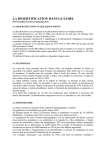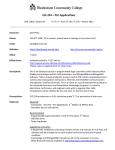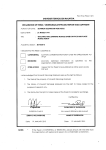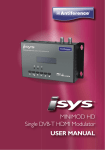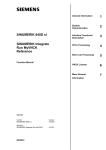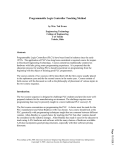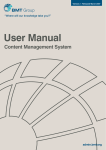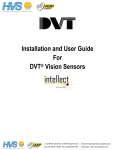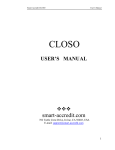Download MANUFACTURING AUTOMATION AND ROBOTICS
Transcript
ENTC 410 - MANUFACTURING AUTOMATION AND ROBOTICS (Revised 8/2015) FALL 2015 TA: Bo Peng (Benjamin) Email: [email protected] Office: Thompson 115CA/002D Instructor: Dr. Sheng-Jen (“Tony”) Hsieh Email: [email protected] Office: Thompson Hall 223 Office Hours: Tues. 2-5 pm & Thur. 2-5 pm Phone: 845-4985 Web Site: http://hsieh.tamu.edu Textbook: 1. Lecture notes, lab exercises, and homework assignments all-in-one volume is available from Copy Corner on Texas Ave. 2. Virtual PLC: http://hsieh.tamu.edu/ References: 1. John W. Webb and R. A. Reis, Programmable Logic Controllers, 6th edition, Prentice Hall, 2006. 2. Frank D. Petruzella, Programmable Logic Controllers, 3rd edition, McGraw-Hill, 2005. 3. Richard A. Cox and Terry Borden, Technician’s Guide to Programmable Controllers, 5th edition, Thompson and Delmar Learning, 2007. 4. Allen-Bradley Control Logix 5550 User Manual, 2006. 5. Jon Stenerson, Fundamentals of Programmable Logic Controllers, Sensors, and Communications (3nd Ed.), Prentice Hall, 2005. 6. Sabrie Soloman, Sensors and Control Systems in Manufacturing, McGraw-Hill, 1994. 7. Adept Robot V+ Programming and Vision System, 1990. 8. Allen-Bradley MicroLogix 1000 and PLC 5 User Manual, 2003. Course Objectives To enhance the student's knowledge and skills in the areas of (1) programmable logic controllers (PLC), (2) sensor technology, (3) industrial robotics, and (4) design and integration of automated systems (e.g., flexible manufacturing cell). In addition, students will exercise the above principles and methodologies in close-toreal-world problem solving. Prerequisites: ENTC 380, 383, 376, and IDIS 300 or approval of instructor. Accreditation Board for Engineering and Technology (ABET) Outcomes This course will focus on the following three ABET required learning outcomes with moderate (M) impact: 2a. Mastery of knowledge, techniques, skills, and modern tools; 2e. Ability to function effectively on teams; and 2f. Ability to identify, analyze, and solve technical problems. Attendance Policy, Make-up Exams, Homework, and Quizzes Students are expected to attend all lectures and lab classes except for an excused University absence (see University Rules). In such cases, you should provide me a copy of the document that supports your absence. Only under this circumstance will any individual be allowed to make up an exam or quiz. If you have more than 3 unexcused absences, one point will be deducted from your final grade for each class you miss. If you maintain perfect attendance, one point will be added to your final grade. Lab reports are due one week from the assigned date, at the beginning of the next lab. Late lab reports will not be accepted for grading. Class environment It is important that we have a good environment for learning in the classroom. Therefore, please do not play games, check email, read newspapers, work on puzzles, or engage in other non-class-related activities during class. If you do one or the above or interfere with a lecture, you will be asked to leave the class and be considered absent for that day’s class. The classroom computers track every online activity you engage in, including applications that you launch and web sites that you visit. You need to sit on your assigned seat. Questions about grading should be addressed after class in my office. Team Semester Project An optional team semester project will involve the application of techniques/methodologies discussed in classes and labs, such as use of sensors, relays, robot, PLC, and interfacing techniques. Most previous projects have been in the area of automating a manufacturing process (e.g., egg packaging). Therefore, an appropriate topic should include an identified product and process. The project will begin after the first monthly exam, and you will be required to submit reports periodically as the semester progresses. If you 1 plan to participate in a project, you should begin thinking about topics as early as possible. Examples of past student projects will be made available for review. An oral presentation and written report will be due st on December 1 2015. Each team should consist of two people. Examples of previous student projects include: 1. Development of a pneumatic-driven robot system 2. Use of PLC for injection molding machine control 3. Multiple robot system collaboration for disk drive assembly 4. Robotic work cell design for egg packaging 5. Automated system for cutting seat belt retractor sleeves 6. Use of vision system for printed circuit board inspection You can find more examples by doing a search for “Automated Assembly System” on YouTube or by reviewing web sites for the following equipment vendors and system integrators: 1. www.adept.com, 2. www.motoman.com, 3. www.abb.com, 4. www.fanucrobotics.com, 5. www.doerfer.com, 6. www.atsautomation.com, 7. www.mikron.com, 8. www.ab.com, 9. www.cognex.com, 10. www.grenzebach.com/index.php/eng/company/grenzebach_automation_gmbh Evaluation criteria for semester projects will be as follows a. Written report (20%) b. Physical model (75% - based on working system, complexity, and creativity) c. Team member evaluation (5%) Format of the report a. Introduction b. Problem to be solved – process to be automated c. Construction of Physical model - Description of major components – CAD drawings, parts and sensors d. Sequence of operations e. I/O ports assignments f. Overall system schematic g. Ladder logic programming – explanation of logic h. Conclusion and future directions i. Appendix – bill of materials Milestones a. b. c. d. e. Week #2 - Approved 1-page concept paper (system layout – prefer CAD including the I/O devices) and part list (Fishertechnik parts and other parts such as from Amazon – budget <= $100) Week #7 - Completion of physical model Week #10 - Wiring and Interfacing Week #12 - Programming Week #13 - Demonstration Grades and Changes All quizzes, lab reports, and exams will be graded and returned as soon as possible. Check with me regarding any grading errors immediately upon receiving your graded paper. Any request to change a grade after this time will not be considered unless you have an excused absence. Your course grade will be calculated as follows: Homework/Quizzes 10% Monthly Exams (3) Lab Assignment 12% Final Exam or Semester Project Lab Final 12% Attendance grade 1% 45% (15% each) 20% Perfect attendance +1% AMERICANS WITH DISABILITIES ACT POLICY STATEMENT The Americans with Disabilities Act (ADA) is a Federal anti-discrimination statute that provides comprehensive civil rights protection for persons with disabilities. Among other things, this legislation requires that all students with disabilities be guaranteed a learning environment that provides for reasonable accommodation of their disabilities. If you believe that you have a disability requiring accommodation, please contact the Department of Student Life, Services for Students with Disabilities, in room 126 of the Koldus Building, or call 845-1637. 2 AGGIE CODE OF HONOR "An Aggie does not lie, cheat, or steal or tolerate those who do." For more information about the Aggie Code of Honor, please visit the Honor Council Rules and Procedures website at http://www.tamu.edu/aggiehonor SAFETY RULES: 1. Turn on PLC power ONLY AFTER all the cable connections are well-connected, including power lines, RS-232 cable, etc. 2. Turn off power supply BEFORE disconnecting power line and RS-232 cable. 3. Don’t touch any power source when your hands are wet. If any of these rules are violated, you will be asked to leave the lab. You will receive a grade of 0 for that lab assignment and will not be allowed to make up the lab. 3 ENTC 410 Class and Lab Schedule NOTE: Topics or labs may not be covered exactly on the date shown and other relevant topics or labs may be covered if time allows. You are responsible for attending class to obtain up-to-date information on topics covered and examination dates. VPLC stands for Virtual PLC. You can access VLPC materials from my web page at http://hsieh.tamu.edu/ under “Virtual PLC.” Week* Lecture* Reading* Lab* Equipment* 1. Introduction to Automation Role of a PLC in an automated system Notes Industrial Automation Case Study Video/ Control Logix 5550 2. Automation Controls – Programmable Logic Controllers (PLC) Structure of a PLC How signal information flows Addressing How programs are executed Notes; VPLC: 1, 2 PLC Hardware/Software Configuration Control Logix 5550 3. Numbering system Stenerson, C2 PLC Instruction Programming Control Logix 5550 4.(Q1) Overview of PLC Instructions Examine On/Off Program structure Boolean algebra MicroLogix 1000 User Manual; VPLC: 3,4 PLC Instruction Programming Control Logix 5550 5*.(T1, 10/2) Timers, Counters TON, TOF, RTO MicroLogix 1000 User Manual; VPLC:3,6 Timer Instructions for Industrial Process Control Control Logix 5550 6. Arithmetic Sequencers CTU, CTD, ADD, SUB MicroLogix 1000 User Manual VPLC: 3,7 Injection Molding M/C App. #1 Control Logix 5550 7. Plant Floor Communication Layers of communication PLC networking AB Communication Protocol Notes Injection Molding M/C App. #2 Device net and Control net 8.(Q2) Actuators: Cylinders, Solenoids, and Relays Valves: structure, functionality, categories & applications Solenoids: structure, functionality, & applications Notes Actuators and PLC Integration Control Logix 5550 and Pneumatics 4 Week* Lecture* Reading* Lab* Equipment* 9. (T2, 10/30) Sensor Technology I Temperature sensors: operating principles, structure, and characteristics Inductive and capacitive proximity sensors: operating principles, structure, and characteristics PLC wiring I Notes VPLC: 8 Proximity Sensors and PLC Integration Industrial Control & Sensor module and Control Logix 5550 10. Sensor Technology II Optical interrupter/Optical reflector Advantages and disadvantages PLC wiring II Notes VPLC: 8 Optical, Proximity Sensors Integration and PLC Industrial Control & Sensor Module and Control Logix 5550 11. Industrial Robots: Programming Industrial robot Configurations Control system Programming Notes Robot programming for material handling task (I) Adept robot 12.(Q3) Industrial Robots: Interfacing Applications Notes Robot programming for material handling task (II) Semester Project Due – 12/1 Micro-robots 13.(T3, 11/23) Automated Systems and PLCs (Software and hardware interface for robot and PLC) Notes VPLC: 8 Cell level machine integration (sensors, motors, switches, robots, and PLC) 14. Machine Vision Notes Lab Final (11/30 to 12/4) 15. Review for Final Exam Notes Final Exam: Monday, December 14th, 8:00 a.m. to 10:00 a.m. 5 Micro-robots, Industrial Control & Sensor Module, Device Net and Control Logix 5550 LAB POLICY COMPLIANCE I fully understand the lab policies and safety rules in this Lab Manual. If I violate the rules, I will be asked to leave the lab and will not be allowed to make up for the lab. By signing below, I am committed to abide to these rules and policies. In addition, I will go to https://howdy.tamu.edu to complete the lab safety training required by the University. Full name: __________________________________ UIN#: ________________________ Lab session (xxx): ____________________________ Signature: ___________________________________ Date: _________________________ 6 LAB REPORT FORMAT 1. Title Page – Lab Number, Name and Date 2. The body of the report should include the following for each task: a. Problem Statements – Task Number b. Sequence of operations c. Input and output devices and terminal address assignments d. Ladder logic program 3. For a detailed example, see these web pages: http://etidweb.tamu.edu/hsieh/CaseStudies/Case1/WidgetAssembly.html http://etidweb.tamu.edu/hsieh/CaseStudies/Case2/Choco-Candy.html 7







